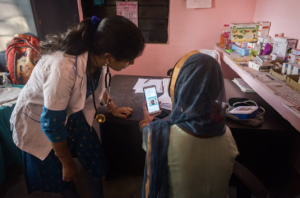The government of Jharkhand has adopted a web-based comprehensive telemedicine solution – eSanjeevani – to extend the reach of specialized healthcare services to masses in both rural areas and isolated communities. eSanjeevani Jharkhand is supported by two models of implementation – eSanjeevani OPD and eSanjeevani AB-HWC (Ayushman Bharat – Health and Wellness Center).
Intelehealth (IH) as a technical partner of Transforming Rural India Foundation (TRIF) and Jharkhand State Government’s Health Department, are the key implementation agencies for eSanjeevani with a focus on strengthening the eSanjeevani AB-HWC model with the following activities: 1) Network creation 2) Supply side strengthening 3) Demand side strengthening and 4) Quality assurance
The following report shares the impact of the implementation support extended by the TRIF – Intelehealth team from May 2021 to March 2022. The inputs provided were:
- Registration, activation and monitoring of hubs and spokes with teleconsultation analytics
- Capacity building of health providers, CHOs (community health officers) and doctors, on eSanjeevani and allied modules to strengthen the teleconsultation service provision
- Post training support to the health providers – technology, clinical and public health
- Provider engagement to motivate and encourage the health providers to initiate and invest in eSanjeevani and increase acceptability of telemedicine
- External doctors’ support through a public private partnership model as an initial catalyst
- Advocacy, review and timely reporting for robust discussion, brainstorming and decisions taken by the government officials to further strengthen teleconsultation services

Key results:
- Total teleconsultations enabled during the evaluation period of this report was 1,75,490 with a 1000x increase in teleconsultations from 50 teleconsultations per month in May 2021 to more than 50,000 teleconsultations per month (as of June 2022).
- Overall, we estimate that the presence of the telemedicine facility saved 21.59 km in distance travelled and INR 941.51 on money saved on average per visit per health visit
- Treatment compliance was 96.5% among those with a prescription or medical advice
- 87.61% clients received medicine at the health and wellness center (HWC)
- 60% patients reported having entirely recovered from their health problems, 25% reported partial recovery
- The CHO was the main driver for opting into the teleconsultation with 36.2% clients choosing to do so on advice of the CHO
- The acceptability of providers towards telemedicine was high, Overall score of 4.01 out of 5 among community health officers and 3.9 out of 5 among doctors from the system

This report focuses on overall activities and results of the implementation support provided by Intelehealth – TRIF partnership to the government of Jharkhand to strengthen teleconsultation services in Jharkhand. The report presents the inputs, activities, outputs, and outcomes of our implementation strategy to further strengthen eSanjeevani teleconsultations.
A number of existing challenges were identified along with recommendations for strengthening the program overall. The key recommendations moving forward include community demand generation and promoting acceptability of telemedicine through ASHAs, Pachayati Raj Institutions and Civil Society Organizations; resolving shortages of doctors through public-private partnerships; improving digital infrastructure at HWCs such as availability of tablets, laptops and internet connectivity; and monitoring & improving the quality of services delivered over telemedicine. In addition, further health impact and outcome evaluation studies need to be planned to better understand the impact of eSanjeevani. Scope for future work includes to assess the social return on investments, impact of the eSanjeevani telemedicine platform on various public health programs for non-communicable diseases, tuberculosis, nutrition and maternal & child health.



